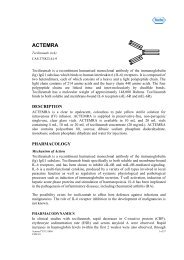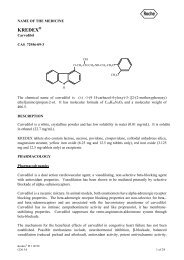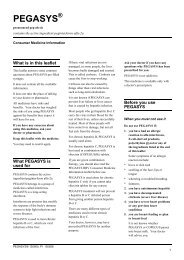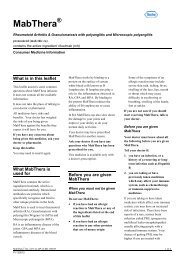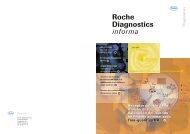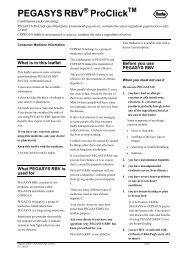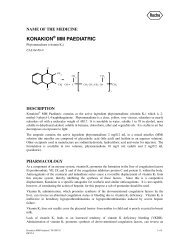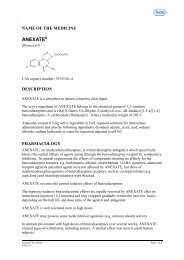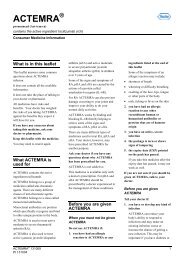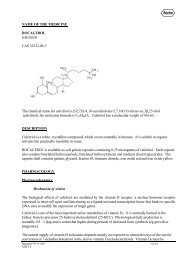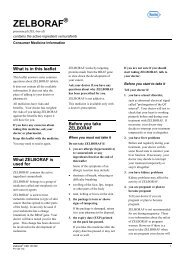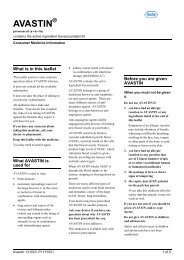Product Information PI - Roche Australia
Product Information PI - Roche Australia
Product Information PI - Roche Australia
Create successful ePaper yourself
Turn your PDF publications into a flip-book with our unique Google optimized e-Paper software.
In a pooled analysis of two seasonal prophylaxis studies in healthy unvaccinated adults (aged<br />
18 – 65 years), TAMIFLU 75 mg once daily taken for 42 days during a community outbreak<br />
reduced the incidence of laboratory-confirmed clinical influenza from 4.8% (25/519) for the<br />
placebo group to 1.2% (6/520) for the TAMIFLU group.<br />
In a seasonal prophylaxis study in elderly residents of nursing homes, TAMIFLU 75 mg once<br />
daily taken for 42 days reduced the incidence of laboratory-confirmed clinical influenza from<br />
4.4% (12/272) for the placebo group to 0.4% (1/276) for the TAMIFLU group. About 80% of<br />
this elderly population were vaccinated, 14% of subjects had chronic airway obstructive<br />
disorders and 43% had cardiac disorders.<br />
In a post-exposure prophylaxis study, household contacts (aged ‡ 13 years) who had no<br />
laboratory evidence of influenza at baseline, and who were living with an index case who was<br />
subsequently shown to have had influenza infection, were randomised to treatment (the intentto-treat<br />
index-infected, not infected at baseline [ITTIINAB] population). In this population,<br />
TAMIFLU 75 mg administered once daily within 2 days of onset of symptoms in the index<br />
case and continued for 7 days, reduced the incidence of laboratory-confirmed clinical<br />
influenza in the contacts from 12% (24/200) in the placebo group to 1% (2/205) for the<br />
TAMIFLU group (risk reduction 91.9%, p < 0.001). For the study population as a whole (the<br />
ITT population), including contacts of index cases in whom influenza infection was not<br />
confirmed, the incidence of laboratory-confirmed clinical influenza was reduced from 7.4%<br />
(34/462) in the placebo group to 0.8% (4/493) for the TAMIFLU group (risk reduction 89%,<br />
p < 0.001). Index cases did not receive TAMIFLU in the study. In the ITT population,<br />
13.9% of contacts in the placebo group and 11.4% of contacts in the TAMIFLU group had<br />
been vaccinated.<br />
Treatment of Influenza in Infants and Children<br />
One double-blind placebo controlled treatment trial was conducted in children, aged 1 – 12<br />
years old (mean age 5.3 years old), who had fever (‡ 37.8 C) plus one respiratory symptom<br />
(cough or coryza) when influenza virus was known to be circulating in the community. Of<br />
698 patients enrolled in this trial, 452 (65%) were influenza-infected (50% male; 68%<br />
Caucasian). Of the 452 influenza-infected patients, 67% were infected with influenza A and<br />
33% with influenza B.<br />
The primary endpoint in this study was the time to freedom from illness, a composite<br />
endpoint which required 4 individual conditions to be met. These were: alleviation of cough,<br />
alleviation of coryza, resolution of fever, and parental opinion of a return to normal health and<br />
activity. TAMIFLU treatment of 2 mg/kg twice daily, started within 48 hours of onset of<br />
symptoms, significantly reduced the total composite time to freedom from illness by 1.5 days<br />
compared to placebo. The median time to freedom from illness in the intent-to-treat infected<br />
(ITTI) population was 5.7 days in the placebo group and 4.2 days in patients treated with<br />
TAMIFLU. In the intent-to-treat population (ITT), the median time to freedom from illness<br />
was 5.2 days in the placebo group and 4.4 days in patients treated with TAMIFLU. The<br />
median time to freedom from illness was significantly reduced in the subgroup of patients<br />
infected with influenza A and treated with TAMIFLU, compared to patients infected with<br />
influenza B and treated with TAMIFLU (not statistically significant). The proportion of<br />
patients developing acute otitis media was reduced by 40% in children receiving TAMIFLU<br />
compared to placebo. Subgroup analyses of this study by gender showed no differences in the<br />
treatment effect of TAMIFLU in males and females.<br />
Tamiflu <strong>PI</strong> 6 mg/mL oral suspension and capsules 120119 9 of 28<br />
CDS 10.0



